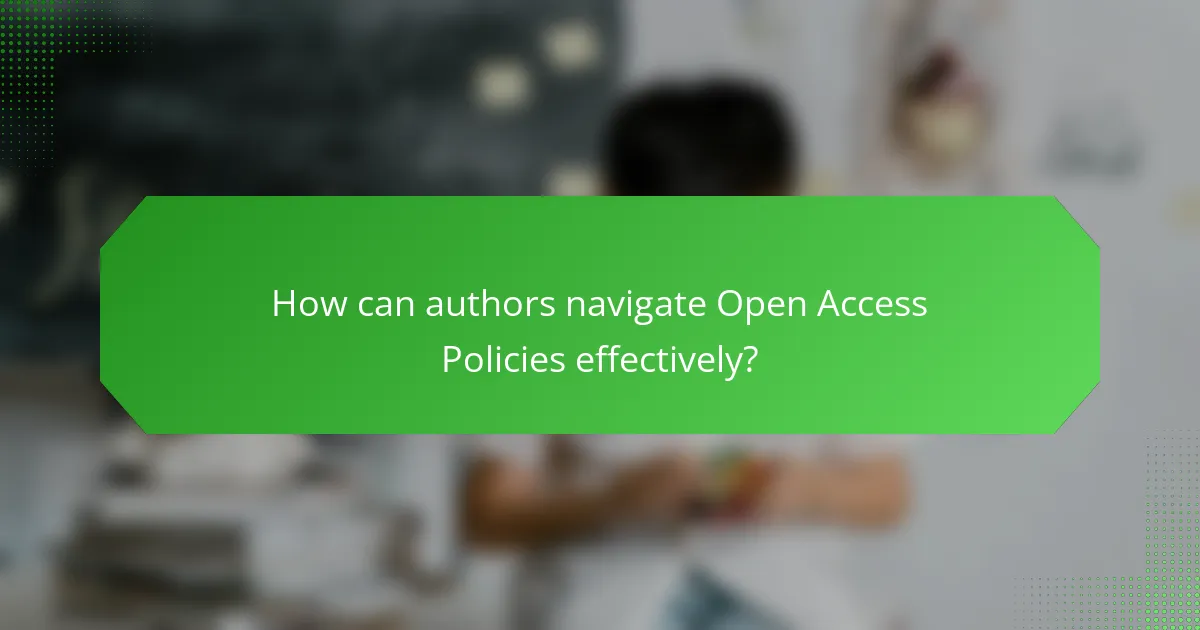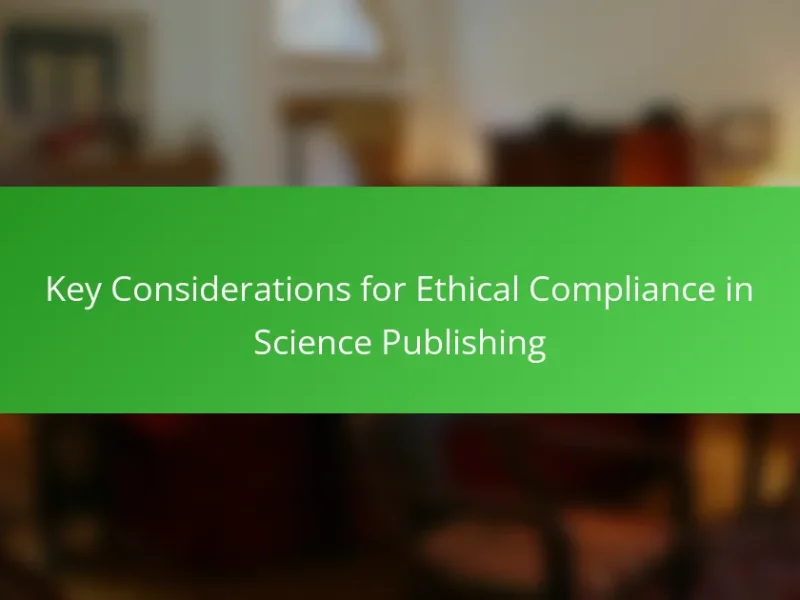Open Access Policies are guidelines designed to facilitate unrestricted access to academic research and publications, eliminating financial and legal barriers. These policies promote the sharing of scholarly work, thereby enhancing research visibility and impact. Key types of Open Access include Green Open Access, which allows authors to self-archive their work in repositories, Gold Open Access, where journals provide immediate access often requiring a processing fee, and Hybrid Open Access, which combines subscription and open access options. Understanding these policies is essential for authors to navigate their specific terms, ensure compliance with funder mandates, and maximize the dissemination of their research.

What are Open Access Policies?
Open Access Policies are guidelines that promote free access to academic research and publications. These policies aim to remove financial and legal barriers to accessing scholarly content. They encourage authors to share their work openly, allowing broader dissemination and visibility. Many institutions and funding agencies implement these policies to enhance research impact. For instance, the European Commission’s Horizon 2020 program mandates open access to research outputs. Open Access Policies can vary in their requirements, including mandates for self-archiving or publishing in open access journals. They play a crucial role in the shift towards more transparent and accessible scientific communication.
How do Open Access Policies impact scholarly publishing?
Open Access Policies significantly transform scholarly publishing by promoting wider access to research. They eliminate subscription fees, allowing anyone to read published studies. This leads to increased visibility and citations for authors. Research shows that articles published under Open Access receive 18% more citations compared to traditional publishing models. Furthermore, Open Access fosters collaboration among researchers across disciplines. It also encourages public engagement with scientific findings, enhancing societal impact. Overall, these policies democratize knowledge and drive innovation in research.
What are the key principles behind Open Access Policies?
Open Access Policies aim to make research outputs accessible to all without financial barriers. They promote the free dissemination of knowledge and support the principle that publicly funded research should be publicly available. Open Access encourages collaboration and innovation by allowing unrestricted access to research findings. It also enhances visibility and citation of research work, benefiting authors and institutions. The policies typically emphasize copyright retention for authors, enabling them to share their work freely. Many funding agencies and institutions are adopting these policies to increase the impact of research. Open Access has been shown to increase the visibility and reach of scholarly work, as evidenced by various studies indicating higher citation rates for open access articles.
How do Open Access Policies vary across disciplines?
Open Access Policies vary significantly across academic disciplines. In the sciences, many journals mandate open access to ensure wider dissemination of research findings. For instance, biomedical journals often require authors to deposit their articles in public repositories. In contrast, the humanities may prioritize traditional publishing models, with fewer open access mandates. Social sciences exhibit a mix, with some fields embracing open access while others remain cautious. The availability of funding for open access fees also differs by discipline. Research shows that disciplines with higher grant funding, like health sciences, have more robust open access policies. Overall, these variations reflect differing values and funding structures within each academic field.
Why are Open Access Policies important for authors?
Open Access Policies are important for authors because they enhance the visibility and accessibility of their research. These policies allow authors to share their work freely with a global audience. Increased access can lead to higher citation rates and greater impact within their field. Studies show that articles published under Open Access receive significantly more downloads and citations compared to those behind paywalls. For example, a study by PLOS ONE found that Open Access articles are cited 18% more than subscription-based articles. Additionally, Open Access promotes collaboration and knowledge sharing among researchers. This can foster innovation and accelerate scientific progress. Overall, Open Access Policies empower authors by broadening their reach and influence in academia.
What benefits do authors gain from adhering to Open Access Policies?
Authors gain increased visibility and accessibility for their work by adhering to Open Access Policies. This approach allows their research to be freely available to a wider audience. Studies show that articles published under Open Access receive significantly more citations. For instance, a study by Piwowar et al. (2018) found that Open Access articles are cited 18% more than those behind paywalls. Additionally, authors retain more control over their work, including the ability to share and disseminate it freely. Open Access also enhances collaboration opportunities with other researchers. Overall, adherence to Open Access Policies leads to greater impact and reach for authors’ research.
How do Open Access Policies affect visibility and citations for authors?
Open Access Policies significantly enhance visibility and citations for authors. These policies allow research to be freely accessible to the public. This increased accessibility leads to a broader readership. Studies show that Open Access articles receive more citations than those behind paywalls. For instance, a 2016 study published in PLOS ONE found that Open Access articles had 18% more citations on average. Furthermore, researchers benefit from higher impact factors in their fields. Open Access also encourages collaboration and knowledge sharing among academics. Overall, these policies create a more inclusive academic environment, boosting authors’ recognition and influence.

What types of Open Access Policies exist?
There are several types of Open Access Policies. They include Green Open Access, Gold Open Access, and Hybrid Open Access.
Green Open Access allows authors to self-archive their work in repositories. This means they can upload their articles to institutional or subject repositories after publication. Gold Open Access refers to journals that provide immediate and free access to articles upon publication. Authors often pay an article processing charge (APC) for this access. Hybrid Open Access combines subscription-based access with the option for authors to make individual articles open access for a fee.
These policies are crucial for increasing the visibility and accessibility of research. They support the principle of making research freely available to the public.
What are the differences between Gold and Green Open Access?
Gold Open Access requires authors to pay an article processing charge (APC) for immediate public access to their work. This model allows anyone to read and reuse the article without subscription barriers. Green Open Access, on the other hand, permits authors to self-archive their work in repositories after an embargo period. In this case, the article may not be freely available immediately but can be accessed later. Gold Open Access often appears in journals specifically designed for this model, while Green Open Access can apply to a broader range of publications. According to the Directory of Open Access Journals, Gold Open Access journals typically charge APCs, whereas Green Open Access relies on institutional or subject repositories. Both models aim to enhance accessibility and visibility of research, but they differ fundamentally in funding and access timing.
How does Gold Open Access work for authors?
Gold Open Access allows authors to publish their work freely available to the public. Authors typically pay an Article Processing Charge (APC) to cover publication costs. This model ensures that anyone can access the published research without subscription fees. The APC varies by journal and can range from a few hundred to several thousand dollars. In return, authors retain copyright over their work. Many journals under this model are indexed in reputable databases, enhancing visibility. Gold Open Access promotes wider dissemination and potential citation of research. It aligns with funder mandates requiring open access to publicly funded research.
What are the implications of Green Open Access for authors?
Green Open Access allows authors to self-archive their work in repositories. This practice enhances visibility and accessibility of their research. Authors retain copyright while making their work available for free. They can share preprints or postprints, increasing engagement with their findings. Green Open Access often leads to wider dissemination and potential citations. It can also support compliance with funding agency mandates. Authors may face limitations based on publisher policies regarding the version they can share. Overall, Green Open Access offers authors a pathway to reach broader audiences while maintaining some control over their work.
What role do institutional repositories play in Open Access?
Institutional repositories play a crucial role in Open Access by providing a platform for the storage and dissemination of scholarly works. They enable researchers to share their publications widely and make them freely accessible to the public. This enhances the visibility and impact of research outputs. Institutional repositories often comply with Open Access mandates from funding agencies and institutions. They facilitate compliance by allowing authors to deposit their works in accordance with specific policies. Furthermore, institutional repositories support long-term preservation of academic content. They ensure that research is accessible over time, regardless of changes in publishing practices. Studies have shown that works in institutional repositories receive more citations than those behind paywalls. This illustrates the positive impact of Open Access on academic visibility and collaboration.
How can authors utilize institutional repositories to meet Open Access requirements?
Authors can utilize institutional repositories to meet Open Access requirements by depositing their research outputs in these platforms. Institutional repositories provide a space for authors to share their work publicly. This practice increases visibility and accessibility of research. Many funding agencies and institutions mandate Open Access compliance. By depositing in a repository, authors fulfill these mandates. Repositories often allow for various types of documents, such as articles, theses, and data sets. This flexibility supports diverse research outputs. Furthermore, institutional repositories often have established workflows to ensure compliance with Open Access policies. This includes metadata standards and licensing options that facilitate sharing. Thus, using institutional repositories effectively meets Open Access requirements and enhances research dissemination.
What are the benefits of depositing work in an institutional repository?
Depositing work in an institutional repository enhances visibility and accessibility. It allows researchers to share their findings with a broader audience. This increased exposure can lead to higher citation rates. Institutional repositories often provide long-term preservation of scholarly work. They ensure that research outputs remain accessible over time, even if the original publisher changes. Additionally, depositing work can comply with funding agency mandates for open access. This compliance can facilitate future funding opportunities. Moreover, institutional repositories can help in showcasing institutional research output. They contribute to the institution’s reputation and academic standing.

How can authors navigate Open Access Policies effectively?
Authors can navigate Open Access Policies effectively by understanding the specific terms and conditions of each policy. They should familiarize themselves with the differences between Gold and Green Open Access. Gold Open Access often requires payment of article processing charges. Green Open Access allows authors to self-archive their work in repositories after a certain embargo period. Authors must check the journal’s policy regarding copyright and licensing options. They should also be aware of funder mandates that may require Open Access publication. Consulting resources like the SHERPA/RoMEO database can provide clarity on journal policies. Engaging with institutional support services can also aid in compliance with Open Access requirements.
What steps should authors take to comply with Open Access Policies?
Authors should follow specific steps to comply with Open Access Policies. First, they must check the funding agency’s Open Access requirements. Many agencies have specific mandates regarding publication in Open Access journals. Second, authors should select a suitable Open Access journal that aligns with their research area. They need to ensure the journal is reputable and indexed. Third, authors should retain copyright or opt for a Creative Commons license when publishing. This allows for wider dissemination and compliance with Open Access terms. Fourth, they must deposit their articles in institutional repositories if required. This ensures their work is freely accessible. Lastly, authors should keep track of their publications and compliance status. This helps in meeting ongoing Open Access obligations.
How can authors determine which Open Access Policy applies to their work?
Authors can determine which Open Access Policy applies to their work by reviewing the specific guidelines of the journal or publisher they intend to submit to. Each journal has its own Open Access Policy, which can typically be found on its website. Authors should look for sections titled “Open Access,” “Author Rights,” or “Submission Guidelines.” These sections outline the policies regarding copyright, licensing, and the availability of articles post-publication. Additionally, authors can consult resources like the Directory of Open Access Journals (DOAJ) for further clarification on policies. Researching institutional or funder mandates can also provide insights into applicable Open Access requirements.
What resources are available to help authors understand Open Access Policies?
Authors can access various resources to understand Open Access Policies. Key resources include institutional repositories that provide policy guidelines. Many universities offer workshops and seminars on Open Access. Online platforms like SPARC (the Scholarly Publishing and Academic Resources Coalition) provide comprehensive information. The Directory of Open Access Journals (DOAJ) lists journals with Open Access policies. Additionally, publishers often have dedicated sections on their websites explaining their Open Access options. The Open Access Scholarly Publishers Association (OASPA) also serves as a valuable resource. These resources collectively help authors navigate and comprehend Open Access Policies effectively.
What common challenges do authors face with Open Access Policies?
Authors face several common challenges with Open Access Policies. One significant challenge is funding for article processing charges (APCs). Many authors lack institutional support to cover these costs. Another issue is the complexity of different policies across publishers. Each publisher may have varying requirements, making compliance difficult. Additionally, authors often struggle with copyright concerns. They may be uncertain about their rights when publishing under Open Access. There is also a lack of awareness regarding the benefits of Open Access. Some authors may not understand how it can increase visibility and citations of their work. Lastly, navigating the submission process can be cumbersome. Authors may find it challenging to determine the best Open Access venue for their research.
How can authors address funding issues related to Open Access?
Authors can address funding issues related to Open Access by exploring various funding sources. Many institutions offer grants specifically for Open Access publication fees. For example, the Wellcome Trust and the Gates Foundation provide funding for researchers. Authors should also consider institutional memberships with publishers that cover Open Access costs. Additionally, authors can apply for article processing charge (APC) waivers based on their financial situation or affiliation. Collaborating with co-authors can also help share publication costs. Furthermore, authors can utilize crowdfunding platforms to raise money for Open Access fees. These strategies help ensure that authors can publish their work openly without financial barriers.
What strategies can authors use to overcome publication restrictions?
Authors can use several strategies to overcome publication restrictions. First, they should familiarize themselves with the specific open access policies of their target journals. This knowledge allows authors to identify permissible preprint uploads or self-archiving options. Second, authors can negotiate copyright agreements with publishers. Many publishers are open to retaining certain rights for authors. Third, authors can seek funding from organizations that support open access publishing. This funding can help cover publication fees. Fourth, authors can consider publishing in journals that have more flexible access policies. These journals often allow for wider dissemination of research. Lastly, authors can advocate for institutional repositories. These repositories can provide a platform for sharing research outputs. Each of these strategies helps authors navigate and potentially mitigate publication restrictions effectively.
What best practices should authors follow when dealing with Open Access?
Authors should ensure their work complies with Open Access policies. They must choose reputable Open Access journals for publication. Authors should verify the journal’s indexing and impact factor. They need to understand the licensing options available, such as Creative Commons licenses. Authors should retain rights to their work when possible. They must disclose any funding sources related to their research. Authors should promote their work through institutional repositories. They need to stay informed about Open Access developments and policies.
How can authors effectively communicate their Open Access choices?
Authors can effectively communicate their Open Access choices by clearly stating their publication preferences in submission guidelines. They should specify whether they choose Gold or Green Open Access. Including this information in cover letters can ensure clarity for editors. Authors can also utilize institutional repositories to archive their work. Engaging with their institutions’ Open Access policies can provide additional support. Furthermore, authors can share their choices on academic networking sites. This increases visibility and informs peers of their access decisions. Research indicates that clear communication enhances the dissemination of scholarly work.
What tips can authors use to maximize the impact of their Open Access publications?
Authors can maximize the impact of their Open Access publications by ensuring wide visibility and engagement. They should choose reputable Open Access journals with strong indexing and readership. Promoting their work through social media platforms increases reach and engagement. Authors can also use academic networking sites like ResearchGate and Academia.edu to share their publications. Engaging with the research community through conferences enhances visibility. Collaborating with other researchers can lead to cross-promotion of work. Finally, authors should encourage citations by making their work easily accessible and relevant to ongoing research. These strategies collectively enhance the impact of Open Access publications.
The main entity of the article is Open Access Policies, which are guidelines designed to facilitate free access to academic research and publications. This article provides a comprehensive overview of Open Access Policies, detailing their impact on scholarly publishing, the key principles behind them, and their significance for authors. It explores the different types of Open Access, including Gold and Green models, and discusses the role of institutional repositories in enhancing research visibility. Additionally, the article addresses common challenges authors face regarding funding and compliance, and offers strategies for navigating Open Access Policies effectively to maximize research impact.


